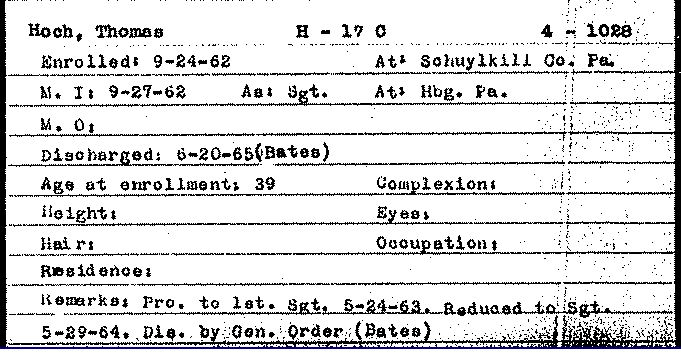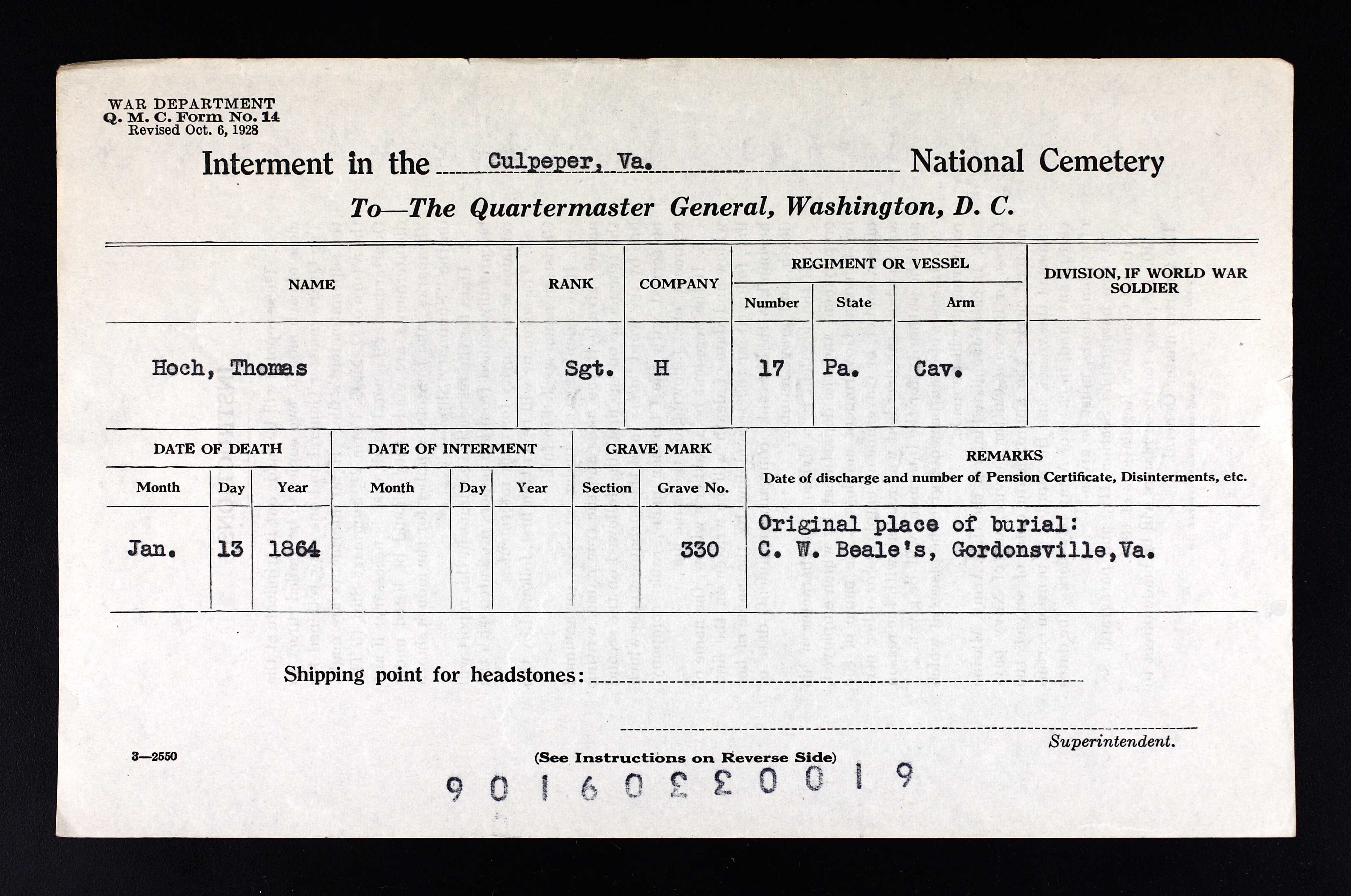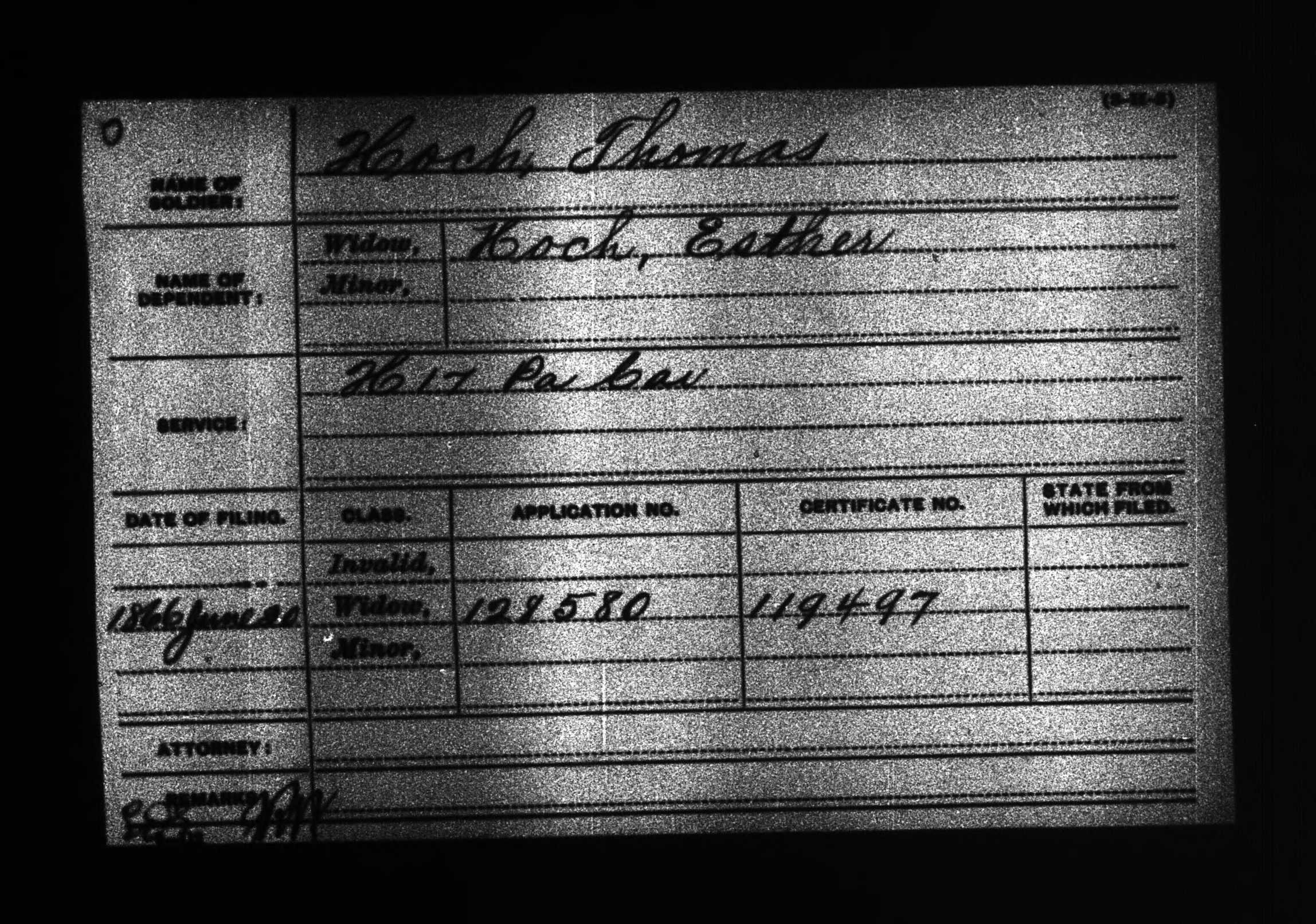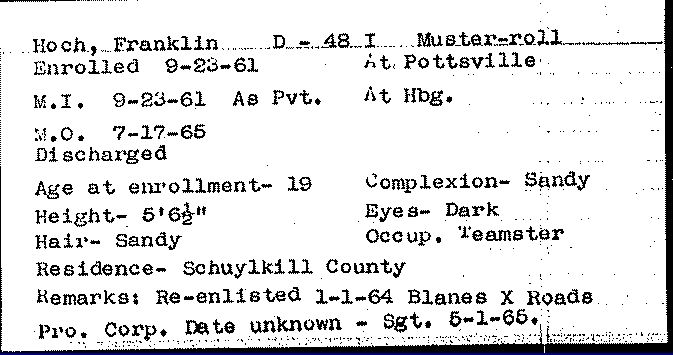Thomas Hoch and Son of Barry Township
Posted By Norman Gasbarro on March 12, 2013
Two more veterans have been added to the Civil War Research Project as a result of being identified in a local area publication as being from Barry Township, Schuylkill County, Pennsylvania. The veterans are Thomas Hoch and his son Franklin Hoch.

On a grave stone in the St. John’s United Church of Christ Cemetery, also known as “Kimmel’s” Church Cemetery, near Ashland, Schuylkill County, Thomas Hoch is recognized with his birth date of 18 February 1824 and the words, “Killed Civil War, VA, 12 June 1864.” His wife, Esther [Heim] Hoch, is buried there. She died on 30 October 1915 at the age of 92 years, 6 months, 27 days, and thus was born on 3 April 1827 (calculated). Family information available on Ancestry.com states that Thomas is actually buried in Culpepper National Cemetery, Culpepper, Virginia. His actual grave marker, if one exists, has not yet been seen.
The Pennsylvania Veterans’ Index Card (shown above) from the Pennsylvania Archives, notes that Thomas Hoch enrolled in the 17th Pennsylvania Cavalry, Company H, as a Sergeant, on 24 September 1862, at Schuylkill County, and was mustered into service three days later in Harrisburg. The card also notes that on 24 May 1863 he received a promotion to 1st Sergeant, but 5 days later was reduced back to his original rank by a General Order. What is odd about this card is that the records of the 17th Pennsylvania Cavalry, according to Bates, have him as discharged on 20 June 1865, more than a year after he supposedly died. Printed in the Bates volume is the following: “Wounded at Trevilian Station, Virginia, 12 June 1864 – discharged by General Order, 20 June 1865.” The only other useful information on the Index Card is Thomas’ age; he was 39 when he enrolled, which would be roughly consistent with the birth date given on the stone at Kimmel’s Cemetery.
The regimental history, from The Union Army, gives the following information about the activities of the 17th Pennsylvania Cavalry up to and including Trevilian Station:
17th Pennsylvania Cavalry – Col. Josiah H. Kellogg, Col. J. Q. Anderson; Lieut.-Col. John B. McAllister, Lieut.-Col. J. Q. Anderson, Lieut.-Col. Coe Durland; Maj. David B. Hartranft, Maj. Coe Durland, Maj. Reuben R. Reinhold, Maj. J. Q. Anderson, Maj. Weidner H. Spera, Maj. Luther B. Kurtz, Maj. William Thompson. The 17th Cavalry, or the 162nd Regiment, was one of the three cavalry regiments furnished by the state under the president’s call of 2 July 1862. It was recruited from the state at large, rendezvoused at Camp Simmons, Harrisburg, and was mustered into the U. S. service during September, October and November 1862, for three years. Col. Kellogg had been a captain in the 1st U. S. Cavalry; a few of the officers and men were Mexican War veterans; but most of the members were devoid of military experience. On 25 November 1862, it left the state for Washington and a few days later was ordered to the front. It first encountered the enemy at Occoquan, Virginia, where it skirmished with Hampton’s Cavalry, and later had a brush with Stuart’s Cavalry at Dumfries. The 17th was assigned to the 2nd Brigade, Col. Devin, 1st Division, Gen. Pleasonton, Cavalry Corps, serving in this brigade and division throughout its term. This brigade furnished the only cavalry present at the Battle of Chancellorsville where Cos. C and I were detailed for escort duty with Gen. Meade and the rest of the regiment assisted in staying the mad onset of Stonewall Jackson’s men when the 11th Corps was routed. It was highly complimented for its coolness by Gen. Pleasonton in a General Order. Next it was engaged at Beverly Ford with the enemy’s cavalry, and again met him at Upperville. Gen. Buford, in command of the division, initiated the battle of Gettysburg on July 1, and was able to hold Hill in check until the forces of Reynolds and Howard reached the field. During the rest of the battle the 17th was employed in preventing flanking movements and in guarding communications with the army’s base. In the pursuit after the battle it was engaged at Boonsboro and skirmished daily thereafter until the enemy escaped across the river. The regiment was almost incessantly active during the indecisive fall campaigns, being often engaged and bearing its full share of the toils and losses until it finally went into winter quarters at Culpepper. Through the winter it picketed a long line towards James City, and toward the close of February 1864, a detail of 200 men under Capt. Spera, joined in Kilpatrick’s Raid to Richmond. On the opening of the spring campaign in 1864 it was engaged throughout May 6, on the left of the line at “the Furnace,” and on the next two days was heavily engaged on the Spottsylvania Road, losing 14 killed and wounded. It then joined in Sheridan’s Cavalry Raid toward Richmond, being active at Beaver Dam Station, Ground Squirrel Church, Yellow Tavern and Meadow Bridge. Rejoining the army on 25 May 1864 it was given but one day’s rest, when it was engaged at New Castle Ferry on the Pamunkey River, driving the enemy, and the next day skirmished at Hanoverton. It was engaged at Old Church on 30 May 1864, losing a number of men. At Cold Harbor the command fought dismounted, losing 22 killed and wounded, and shortly after, when Sheridan led the cavalry towards Lynchburg, it was hotly engaged near Trevilian Station, losing 5 killed, 19 wounded and 2 missing.
Supposedly, the wounded Thomas Hoch was taken to Gordonsville, Virginia, where he died on 13 January 1864, as is stated in the Interment Record (below), at first buried there at Gordonsville, and then re-interred in the National Cemetery at Culpepper (see record below). Why the interment record indicates the death was in January is not known. Other records have the death date in June, which if consistent with the time that his regiment was at Trevilian Station, would be the correct date of death. Note: Each time such an error is found in one of these secondary source records, it emphasizes the necessity of consulting the primary source documents (or as close to the primary source documents) as possible.
It is not known why this information was not coordinated properly with the records of the 17th Pennsylvania Cavalry. The date of death on the Interment Record is one day and five months off from the date on the stone at Kimmel’s Church Cemetery.
The widow, Esther [Heim] Hoch, did not apply for survivor’s benefits until June 1866, two years after her husband’s death, as shown by the Pension Index Card (above, from Ancestry.com). She received a pension which she collected until her death in 1915 – more than 50 years after she was widowed by the war!
In further researching the life of Thomas Hoch it was discovered that he was born in Lykens Township, Dauphin County, the son of Abraham Hoch (1791-18743) and Maria Barbara [Kaercher] Hoch (1790-1863), though additional information is needed to confirm Lykens Township as his birthplace. At the time Thomas enlisted, he was a farmer living in Schuylkill County and he and his wife Esther had about 14 children – only a few of whom had not survived to 1862. Those children were: Franklin Hoch (born about 1844); Joseph Hoch (born about 1845); Emeline Hoch (born about 1847 and died young); Sarah Jane Hoch (born about 1848); William Edward Hoch (born about 1849); Elizabeth Hoch (born about 1850); Catherine Hoch (born about 1851); Pierce Hoch (born about 1852, and died about 1855); Benjamin Hoch (born about 1854); Thomas Hoch (born about 1855); Mary Ann Esther Hoch (born about 1858); Amanda Hoch (born about 1859 and died young); Diana Hoch (born about 1860); and Matilda Hoch (born about 1863, later to die about 1870).
The oldest son of Thomas Hoch and Esther Hoch, Franklin Hoch, also served in the war.
The 19-year old Franklin Hoch, enrolled on 23 September 1861 at Pottsville and was mustered into service in Harrisburg on the same day in the 48th Pennsylvania Infantry, Company D, initially as a Private. At the time of his enrollment, he was employed as a teamster, lived in Schuylkill County, and stood nearly 5 foot, 7 inches tall, with a sandy complexion, dark eyes and sandy hair. The Pennsylvania Veterans’ Index Card (above, from Pennsylvania Archives) notes that he survived the war, including a re-enlistment on 1 January 1864 at Blaine’s Crossroads, Tennessee, through to his discharge on 17 July 1865. During his time of service, he was promoted to Corporal and then to Sergeant, dates unknown.
From the official history of the 48th Pennsylvania Infantry, found in The Union Army:
The 48th Regiment, composed of Schuylkill County men, was mustered into the U. S. service for a three years, term, in September 1861, at Camp Curtin, Harrisburg. It embarked at Baltimore on 25 September 1861 for Fortress Monroe and arrived there the next day. Remaining here until 11 November 1861, it was ordered to Hatteras Island, N. C., and made its winter quarters in that vicinity. It shared in the victory at Roanoke Island in February 1862, after which four companies were detailed to garrison the fort at Hatteras Island and the remainder of the regiment sailed for New Berne. This detachment rendered valuable service during the Battle of New Berne in transporting ammunition for the troops engaged. With the 1st Brigade of Gen. Reno’s Division, the entire regiment was ordered to Fortress Monroe, where it arrived on 8 July 1862. In August it joined Gen. Pope’s Army at Culpeper; participated in the battles of the Second Bull Run, Chantilly, South Mountain, Antietam and Fredericksburg, fighting valiantly in every engagement and winning many compliments for gallantry. On 11 February 1863, the 48th was ordered to Newport News, remaining there until late in March 1863, when it proceeded to Lexington, Kentucky, where it was posted on guard duty from 1 April 1863 to 10 September 1863 It was then ordered to East Tennessee and assigned to the 1st Brigade, 2nd Division, 9th Corps, with which it engaged at Blue Springs, Campbell’s Station and Knoxville. In December 1863 many of the regiment reenlisted and the 48th continued in the field as a veteran organization after the usual veteran furlough. In the same brigade as heretofore it shared in the arduous Wilderness Campaign, repeatedly in action and suffering heavy losses. It proceeded to Petersburg and joined in a successful assault on an outpost on 17 June 1864, in which Sgt. Patrick Monahan of Company F and Pvt. Robert Reid of Co. G received Medals of Honor for gallantry. The month of July was spent in excavating the mine that was exploded 30 July 1864 with such terrible effect. The men were without adequate tools for such labor and it was only accomplished by the utmost endurance and persistence. For this work they were complimented in orders by Gen. Meade. On 2 August 1864 the regiment was attached to the 1st Brigade, 2nd Division, 9th Corps, with which it engaged the enemy at Poplar Spring Church. In December the regiment was stationed at Fort Sedgwick, where it remained until 2 April 1865, when it joined the assault on Fort Mahone, after which it occupied Petersburg and was detailed to guard prisoners, etc., until the middle of July, when it returned to Alexandria and was mustered out on 17 July 1865.
From other information about Franklin Hoch, it was learned that he was wounded at Antietam and recovered in a hospital in Baltimore. According to his veterans’ record card, he was able to return to the regiment and although the actual date of return has not yet been seen, it can be assumed that was with the 48th Pennsylvania Infantry when he re-enlisted on 1 January 1864. If his father died in June 1864, it can be assumed that Franklin was in the area of Peterburg at that time. At this time, no information has been seen as to how he received the news of his father’s death.
After the war, Franklin Hoch returned to Schuylkill County and in about 1867 married Marguerite Black. Information is sketchy at this time on his post-war activities, but it is known that he and Marguerite had at least three children: Laura M. Hoch (born about 1869); Thomas Benjamin Hoch (born about 1873); and Blanche Hoch (born about 1879).
The Pension Index Card (shown above from Ancestry.com) shows that Franklin was an early pension applicant (1869) and that he received a pension relatively early (the low certificate number). His war injuries, received at Antietam, must have played a part in getting the early benefits. Information is probably available in the pension application file, available at the National Archives in Washington, D.C., which has not yet been consulted. In 1890, Franklin Hoch was living in Clearfield County, Pennsylvania, and although his service in the 48th Pennsylvania Infantry was reported, the census-taker failed to record other vital information such as his post office address and any Civil War-related disabilities.
After his death in 1912, Franklin Hoch was buried at Frieden’s Cemetery, Valley View, Schuylkill County, Pennsylvania. His stone notes his service in the 48th Pennsylvania Infantry as well as his membership in the Kinkead Post of the G.A.R. Franklin’s widow, Margaret Hoch, died in 1925, and was able to collect pension benefits following her husband’s death.
——————————
The initial information on Thomas Hoch and Franklin Hoch as Civil War Veterans was obtained through Our Veterans, Our Heroes, by Annabelle Coleman. Additional information is sought on Thomas Hoch and Franklin Hoch, including pictures and stories (if available) and may be added to this post in “comments” or sent via e-mail to the Civil War Research Project.
 ;
;








Thomas Hoch’s headstone can be seen on http://www.findagrave.com. It is located at Culpeper Ntl. Cemetery.
Amanda Hoch, his daughter, married Richard Monroe Thomas. They had 11 children and she lived to age 99. She died in 1959 in Shamokin, Pa.
In 2015 we visited the grave of my GGGrandfather, Thomas Hoch in Culpepper, VA. A marker at the cemetery, indicated 7,000 of the soldiers buried there , were first buried at the Gordonsville Exchange Hotel, VA. When we went to the Hotel, we found a notebook in the surgery room having the names of some (certainly not all) soldiers who were known to have died there. My GGGrandfather’s name was in the book; I felt relieved to have proof of his place of his death.